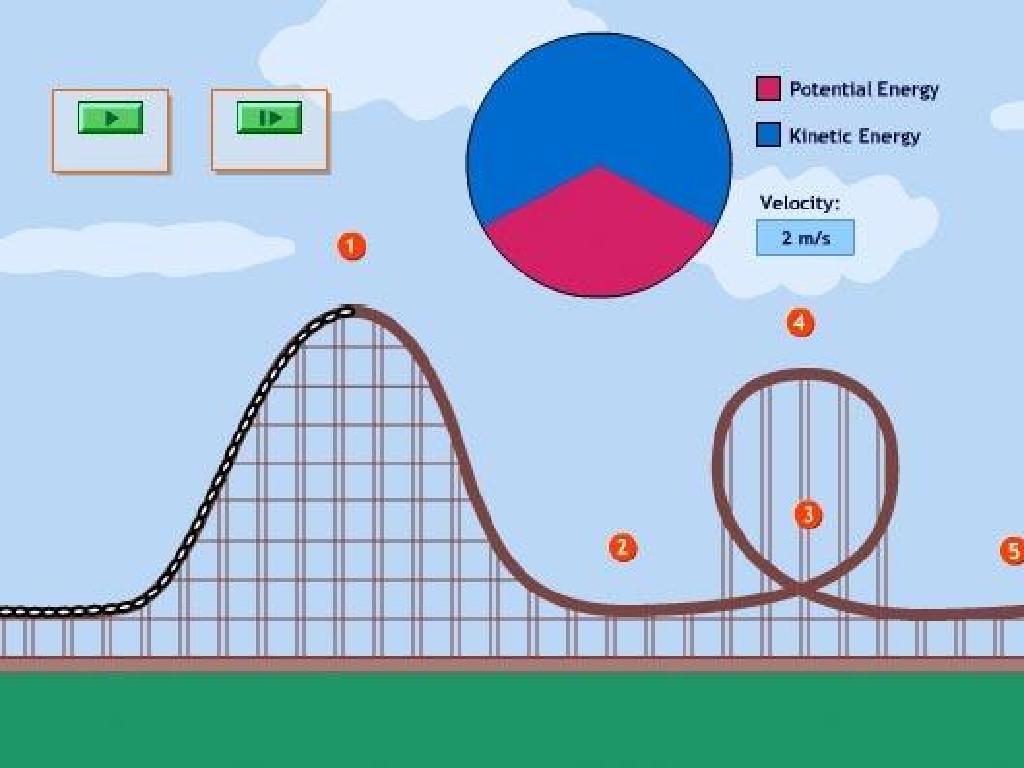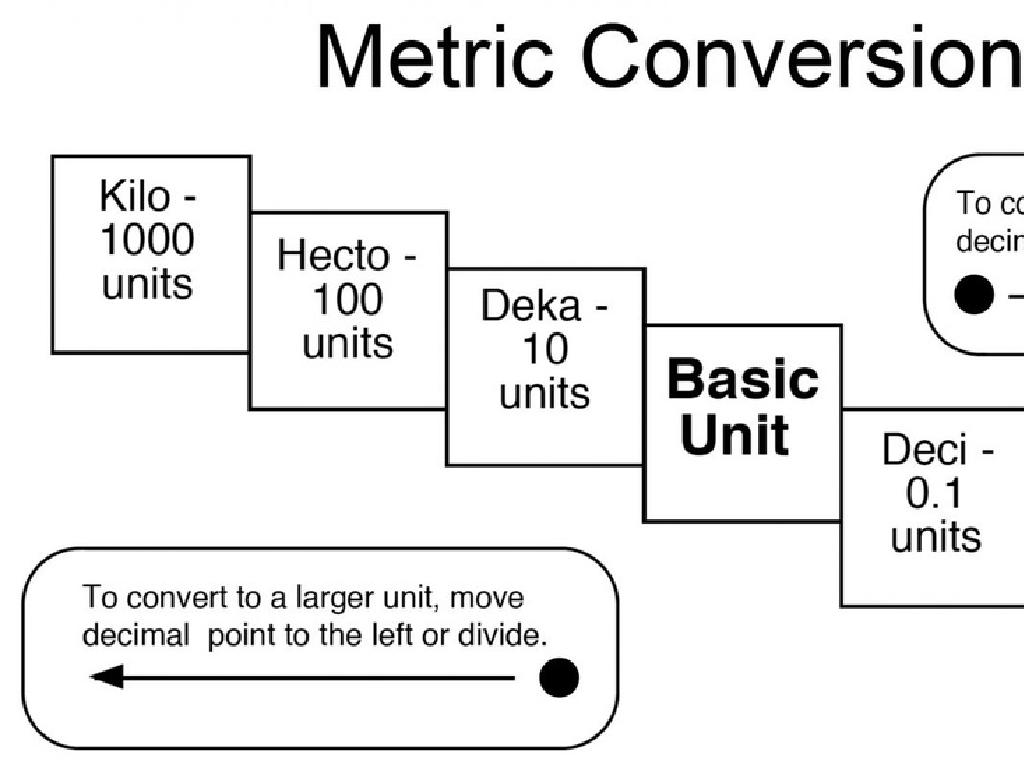Estimate To The Nearest Ten
Subject: Math
Grade: Second grade
Topic: Estimation And Rounding
Please LOG IN to download the presentation. Access is available to registered users only.
View More Content
Welcome to Estimation: Nearest Ten!
– What is estimation?
Estimation is finding a number close to the exact amount.
– Why learn estimation?
Estimation saves time and helps in quick decisions.
– Estimation in daily life
Useful for guessing time, money, or amounts in everyday situations.
– Practice rounding to ten
Round numbers up or down to the nearest ten to estimate.
|
This slide introduces the concept of estimation, specifically focusing on rounding numbers to the nearest ten. Begin by explaining that estimation is a way to find a number that is close enough to the right answer, which can be quicker and easier than finding the exact number. Emphasize the importance of estimation in making fast decisions and simplifying calculations in everyday life, such as estimating the cost of groceries or the time needed to travel somewhere. Engage the students with examples and encourage them to think of situations where they have used or could use estimation. Conclude by showing how to round numbers to the nearest ten, which is a practical skill they will practice in class.
Understanding Estimation
– Estimation is a math guess
– Think of estimation like guessing the number of candies in a jar!
– It finds a close enough number
– If you have 23 apples, estimating to the nearest ten gives you 20.
– Used when exactness isn’t needed
– Like when measuring a room for a carpet, you don’t need the exact size.
– Practice with rounding to ten
|
This slide introduces the concept of estimation, which is a fundamental skill in mathematics, especially useful when an approximate number is sufficient. Estimation is compared to making an educated guess, which makes it relatable and easier to understand for second graders. Emphasize that estimation is not about finding the perfect answer but rather a number that is ‘close enough.’ Provide examples where exact numbers are not necessary, such as when measuring something where a precise number isn’t needed. Encourage students to think of times they have used estimation in their daily lives. Conclude by explaining that one way to estimate is by rounding numbers to the nearest ten, which will be practiced in class.
Rounding Numbers to the Nearest Ten
– Rounding makes estimating easy
– Numbers 5 or more, round up
– If it’s 15, we round up to 20
– Numbers less than 5, round down
– If it’s 14, we round down to 10
– Practice with examples
|
This slide introduces the concept of rounding numbers as a fundamental skill in estimation. Rounding to the nearest ten simplifies numbers to make them easier to work with. Explain that when the ones digit is 5 or more, the number is rounded up to the next ten. Conversely, if the ones digit is 4 or less, the number is rounded down to the previous ten. Provide clear examples, such as rounding 15 to 20 because the ones digit (5) is 5 or more, and rounding 14 to 10 because the ones digit (4) is less than 5. Encourage students to practice with different numbers and to check their understanding by asking questions. Prepare a few exercises for them to round numbers to the nearest ten as a class activity.
Let’s Practice Rounding to the Nearest Ten!
– Example: Round 14 to the nearest ten
– Decide: Is 14 closer to 10 or 20?
– Is 14 more than halfway to 20 or not?
– Rule: If the last digit is less than 5, round down
– Numbers ending in 1, 2, 3, or 4 round down
– Result: 14 is rounded down to 10!
– Since 4 is less than 5, 14 rounds down to 10
|
This slide introduces students to the concept of rounding numbers to the nearest ten. Start with a clear example, like rounding the number 14. Ask the students if 14 is closer to 10 or 20 to help them visualize the concept of rounding. Explain the rule that if the last digit in the number is less than 5, we round down to the nearest ten. If it’s 5 or more, we round up. In our example, since the last digit is 4, which is less than 5, we round down to 10. Encourage students to practice with more examples and to explain their thinking process. This will help solidify their understanding of rounding numbers.
Estimating with Real Objects
– Observe items around you
– Guess the total count
– Round to the nearest ten
– If there are 23 pencils, we say about 20.
– It’s fine to not be exact
|
This slide is designed to introduce students to the concept of estimation. Encourage the children to look around the classroom and make a guess about the number of certain items they see, such as books, pencils, or chairs. Explain that estimation is a way to find a number that is close enough to the right answer, usually by rounding. Teach them how to round numbers to the nearest ten, and emphasize that estimations do not have to be exact, but they should be reasonable. For example, if there are 23 pencils, we round down to 20 because it is the nearest ten. If there are 25, we round up to 30. This activity will help them understand that estimation is a useful skill for making quick and reasonable number approximations.
Class Activity: Estimation Station
– Break into small groups
– Estimate classroom items
– Guess how many items are in a jar or on a shelf
– Share and explain estimates
– Discuss with your group why you think that’s the number
– Closest estimate wins!
|
This activity is designed to be a fun and interactive way for students to practice estimation. Divide the class into small groups and assign each group a set of items to estimate within the classroom. It could be anything from the number of books on a shelf to the number of blocks in a container. After the estimation, each group will explain the reasoning behind their guesses, allowing them to understand each other’s thought processes. The group with the estimate closest to the actual number will be celebrated. As a teacher, prepare a variety of items for estimation and ensure that each group has a chance to estimate multiple items. Encourage students to think about rounding numbers to the nearest ten and use that to make their estimates. This will help them understand the practical application of estimation and rounding in everyday situations.
Estimation Mastery: Great Job!
– Congratulations on learning estimation!
– Estimation is useful in math and daily life
– Like guessing the number of candies in a jar
– Keep practicing to become an expert
– Practice with different numbers every day
– Proud of your progress in rounding numbers
|
This slide is a celebration of the students’ efforts in learning to estimate to the nearest ten. It’s important to reinforce the value of estimation as a skill that extends beyond the classroom and is applicable in real-world scenarios, such as making quick calculations when shopping or planning time. Encourage the students to continue practicing with various numbers to solidify their understanding and proficiency. Acknowledge their hard work and progress, and motivate them to keep improving. You can suggest fun estimation activities for them to do at home, like estimating the number of steps from their room to the kitchen or the number of toys they have.






